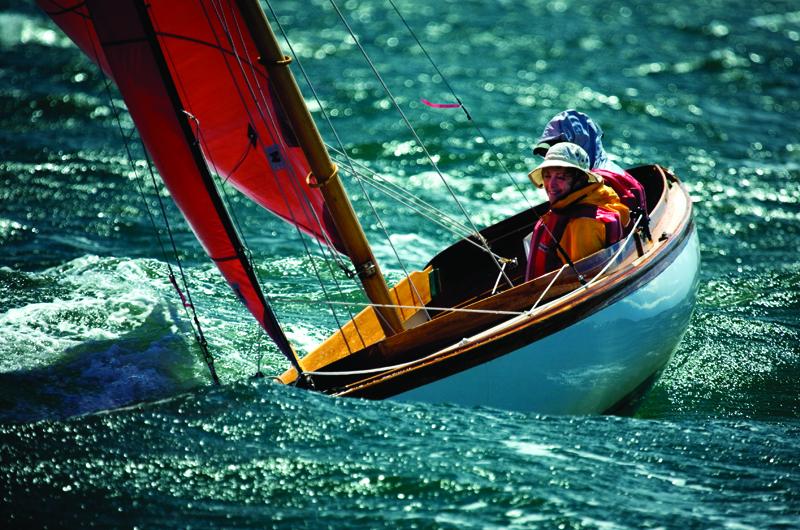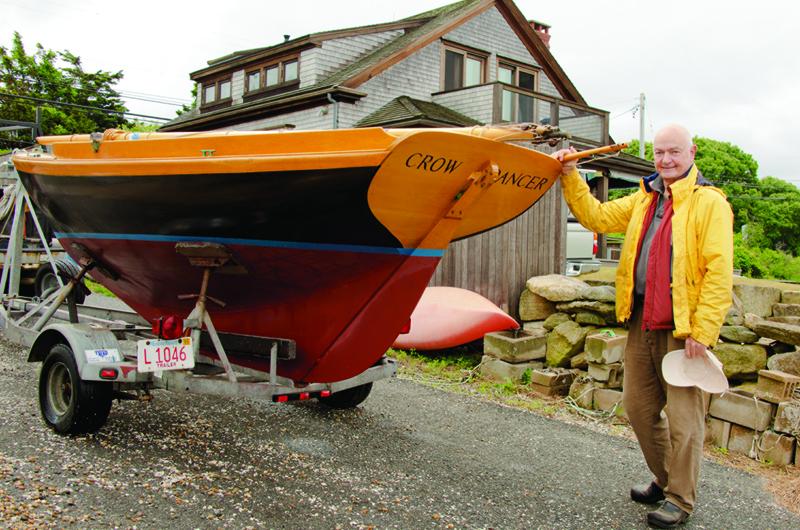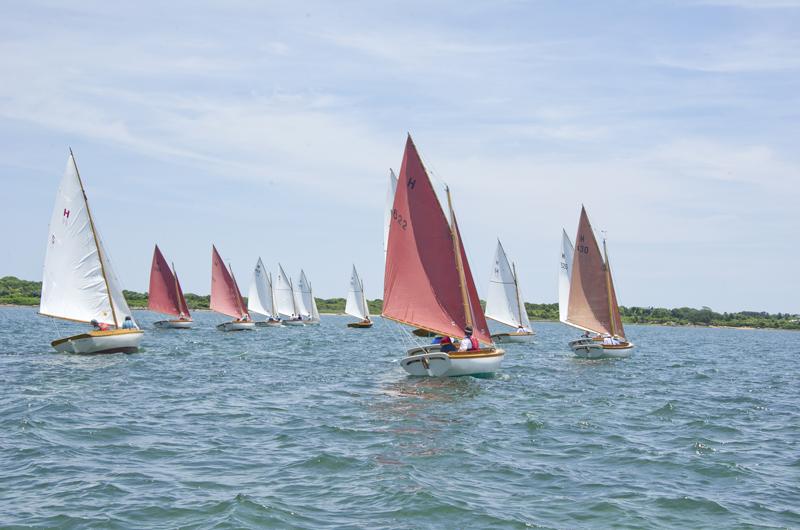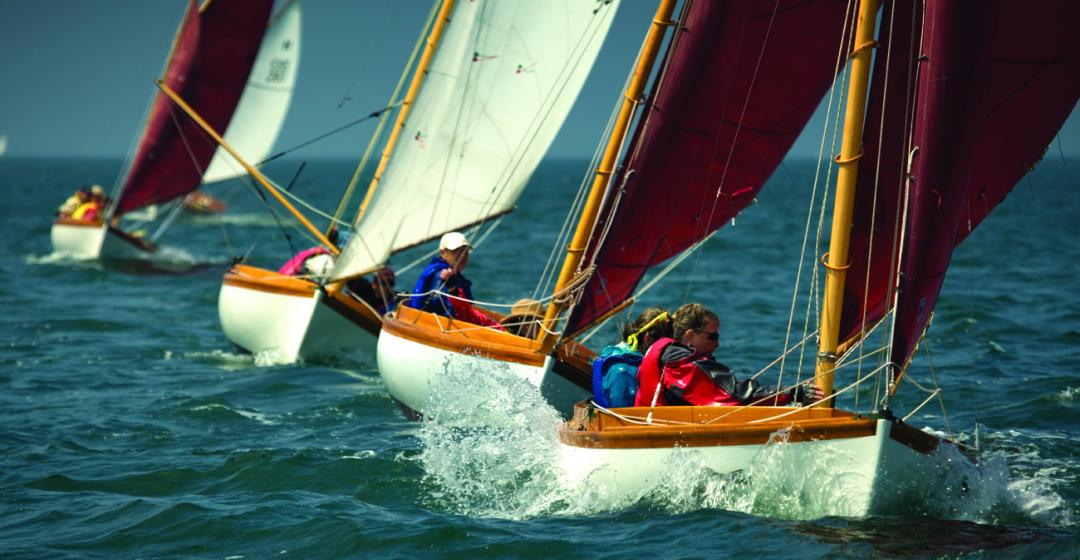It was all very genteel, downright “Corinthian” as sailors would say, referring to the British tradition of “gentlemen sailors” who race around buoys for the pure honor of being able to say they won. But even though there were to be no Bowie knives thrown or hogs running wild, there was nonetheless a whiff of the Hatfields meeting the McCoys when the Edgartown Yacht Club and Menemsha Pond Races Herreshoff 12 1/2 (H-12) fleets agreed to tangle this summer for the first time in the Vineyard Herreshoff Cup.
“There’s a difference between Edgartown and Chilmark,” said Edward Miller, who has sailed in the Menemsha fleet for nearly a decade. Residents of both towns would be happy to apply that statement to any number of categories, from sartorial, to architectural, to, if Island stereotypes hold, political. But Miller was talking strictly nautically. “Our racing is a bit more casual. It’s serious, but casual.”
“I’m sure there’ll be a bit of boasting and breast beating,” predicted Edgartonian Don McLagen, who serves as the Edgartown co-fleet captain. “Having a rivalry is good. The Edgartown fleet hosted the [H-12 class] national championship last year and the guys who came up from Menemsha did well. We think we have good sailors as well.”
What the two groups share is a love of sailing a legendary boat that was first designed and built exactly a century ago by the man some consider to be America’s greatest yacht designer. Of the more than five hundred boats designed by Nathanael Greene “Capt. Nat” Herreshoff, the H-12 is the only one that bears his name. It’s easy to handle, with a wide-open cockpit, and is the perfect boat to while away the lazy, laconic days of summer. Even if the name H-12 is a bit less than poetic off the tongue, with its gaff rig and sometimes tan bark-colored sails, the H-12 is made for an artist’s rendering of a beach-side landscape.
H-12s have been a fixture around New England from Buzzards Bay to Maine for the past century, but boats are located throughout the U.S., and one is registered as far away as Turin, Italy. Today, more than sixty of the boats race among the fleets in Edgartown and Menemsha. Usually, however, they stay in their own corners of the Island and race in distinctly different formats. Each fleet has had its share of national and town champions, but bringing them together has never happened. Never before this summer, that is.
“Last year I did the nationals in Edgartown and afterward sent a challenge to Don [McLagen],” explained Miller, “and he picked up the gauntlet.”
The date was set for the last week of June, with the first “Herreshoff Cup” to be held on Menemsha Pond. (It was Miller’s idea, after all.) The invitations went out: any crew from either fleet was welcome, though only the top three crews from each team would be designated a “scoring crew” when it came to awarding the trophy, a handsome silver cup. He may be more casual than the average Edgartonian, but Miller is not the type of fellow to do anything halfway.

Lest any recipients of the invitation take the rivalry too seriously, however, the race notice included the following reminder: “The Vineyard Herreshoff Cup is intended to be a Corinthian competition between like-minded devotees of both recreational racing and the Herreshoff tradition. Competitors are discouraged from aggressive maneuvers and/or threats intended to intimidate other sailors and are further encouraged to exonerate themselves after committing a breach of the...Racing Rules of Sailing.”
For sailors, the “Herreshoff tradition” refers to the brand of polite but highly competitive and innovative racing that made Herreshoff and his older brother, John Brown Herreshoff, regular champions racing on Narragansett Bay in the late nineteenth century. The Herreshoff Manufacturing Company, which the Herreshoffs opened in Rhode Island in 1878, was famous for its uncanny ability to create fast and stylish boats. Between 1893 and 1914, Herreshoff designed and built seven of the largest, most powerful, and complex racing sloops ever seen. Five were selected to sail as America’s Cup defenders, all of them victorious.
At twelve and a half feet at the waterline, the H-12 would clearly seem to be a boat of a different class, but there is, in fact, a direct line between the familiar boat of today and the Resolute, which was designed to race in the 1914 America’s Cup. The managing director for the Resolute as it prepared for the defense of the cup was Robert W. Emmons II, of Boston. Emmons was a Harvard educated brahmin’s brahmin who started his sailing career in catboats on Vineyard Sound and Buzzards Bay before becoming a very successful amateur skipper in international events. Under his strict management Resolute handily beat its defense rivals Vanitie and Defiance in the selection trials, and would have been the defender of the 1914 America’s Cup had the outbreak of World War I not prevented the British challenger from crossing the Atlantic, which forced a postponement of the match until 1920.
The silver lining for the sailing world was that at some point during the process of building Resolute, Emmons commissioned Herreshoff to design and construct a small boat he called the Buzzards Bay Boy’s Boat. Previously Emmons had commissioned Herreshoff to design and construct a daysailer of fifteen feet length on the waterline (twenty-four feet length overall) that was later known also as the “E Class.” But he and his friends wanted an even smaller boat, one that would be easier for their sons to handle on the choppy waters of Buzzards Bay, where they summered.
Herreshoff was what you might call a “notebook man.” He made notes as to certain features that the design should incorporate, but he never drew an official set of lines for his designs. Instead, he carved all of his designs free-hand from white pine or poplar blocks. He’d start with a planer and work on down to fine grit sandpaper. Only when he was happy with the look of the hull would he take offsets from the finished carving to develop the lines for the designs, which were often drawn by an office draftsman. The final carving he produced for Emmons was similar to Herreshoff’s own Alerion 3, a 26-footer that he built in 1912, but it measured in at 12 feet, 6 inches on the waterline with a gaff rig.

The Buzzards Bay Boy’s Boat that emerged in 1914 was priced at $420, not an insignificant sum of money that today equates to nearly $10,000. Nonetheless, Emmons apparently convinced twenty of his friends to each buy one of the new boats; the list of the original owners reads like a who’s who of Boston, suggesting that Emmons approached potential owners personally while riding the train on weekends to and from Boston.
To combat the choppy waters of Buzzards Bay and to increase safety factors, the H-12 has a beam of 5 feet, 9 inches, and displaces 1,500 pounds. The boat has ample stability with 750 pounds of fixed ballast. Despite the ballast, the wide-open cockpit was easy to swamp due to the low freeboards, but through time the H-12 has proven nearly indestructible. Not to mention addictive to a growing company of Island fans.
“It’s a boat designed for kids to sail safely in sloppy conditions; it’s a boat that tests seamanship in ways that other designs might test brinksmanship,”
said McLagen. “In some ways it’s an antidote to the carbon fiber. It’s a boat of enormous distinction and tradition.”
“The Herreshoff H-12 was perfectly designed for the waters of southeastern New England,” echoed Tom Dunlop, the owner of Lila, a forty-year-old fiberglass copy of an original H-12, known as a Doughdish.
It’s somewhat surprising, therefore, that it took more than half a century for the boat to make a permanent appearance in Edgartown. In the summer of 1975, Dunlop’s stepfather, D. Norman Brady, the rector at St. Andrew’s Episcopal Church, purchased and launched the first Doughdish in Edgartown harbor. The manufacturer, Bill Harding, took great care to ensure his fiberglass models were equal in weight to the wood H-12 versions, which were 100 to 150 pounds heavier than the fiberglass models prior to launching. The boat’s beauty and ease of use captured people’s attention, and by 1976-78 a fleet had begun to swell.

Clare G. Harrington first saw the small gaff-rigged boats when approaching Edgartown on a summer cruise to Martha’s Vineyard with a friend in 1982 and thought they looked stylish and fun. She returned a couple of years later to see even more of the colorful spinnakers flying about, and again admired them but had no idea what she was ogling. Then, during a H-12 national championship in Edgartown in 1984, she rowed over as competitors were securing their boats and happened upon none other than Harding, the builder of the Doughdish.
In 1988 she bought her own Herreshoff. “Once I bought the boat I realized where I had to move to: I had to go to Edgartown,” said Harrington, who this year became the first female commodore in the 109-year history of the Edgartown Yacht Club. “I didn’t know a soul, but the boat brought me here.
“At the time it never even occurred to me to qualify as a member of Edgartown Yacht Club, much less be commodore,” she said. “I couldn’t even begin to imagine all of that, but here I am. I’ve raced her for many years and still have her.”
The boat’s association with the Vineyard was cemented in celluloid when the producers of the Jaws films noticed the H-12 sailing about and thought it looked like a slice of New England. It was too late to include the boat in the first movie, but the H-12 made a few appearances in the second, skippered by the then-teenaged Dunlop. “I’ve sailed one on the Atlantic and Pacific Oceans and the Gulf of Mexico, and I can attest to it being a tremendous boat. It even does well when rammed by a mechanical shark!
“When we were filming in the Gulf of Mexico we were hit by a water spout,” he recalled. “Only two boats were able to operate after the storm, a Boston Whaler and the H-12. They go through anything. They are stalwart, powerful and fun to sail in any breeze.”
Fortunately, there were no waterspouts or white sharks in Menemsha Pond on the race days. The weekend was as classic as the boats themselves, with blue skies and a light but building wind from the southwest. Eight boats from Menemsha Pond and six from Edgartown raced five times over two days.
“It couldn’t have been a bigger success,” said an elated Miller when it was all over. “Everyone had a fantastic time, beyond my wildest dreams. The spirit was fantastic. We had a wonderful meal for the captains and crews. And everyone promised to come back again next year.”
Which is another way of saying that when the racing was done, the home course advantage held and the Vineyard Herreshoff Cup remains, for now at least, in Menemsha.





